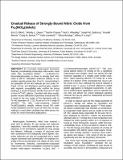Files in this item
Gradual release of strongly bound nitric oxide from Fe2(NO)2(dobdc)
Item metadata
| dc.contributor.author | Bloch, Eric D. | |
| dc.contributor.author | Queen , Wendy L. | |
| dc.contributor.author | Chavan, Sachin | |
| dc.contributor.author | Wheatley, Paul Stewart | |
| dc.contributor.author | Zadrozny, Joseph M. | |
| dc.contributor.author | Morris, Russell Edward | |
| dc.contributor.author | Brown , Craig M. | |
| dc.contributor.author | Lamberti, Carlo | |
| dc.contributor.author | Bordiga, Silvia | |
| dc.contributor.author | Long , Jeffrey R. | |
| dc.date.accessioned | 2016-02-24T00:11:58Z | |
| dc.date.available | 2016-02-24T00:11:58Z | |
| dc.date.issued | 2015-03-18 | |
| dc.identifier | 181706422 | |
| dc.identifier | 89062c70-4d6d-42c4-bf7c-fa1f1c419664 | |
| dc.identifier | 84925277989 | |
| dc.identifier | 000351420800007 | |
| dc.identifier.citation | Bloch , E D , Queen , W L , Chavan , S , Wheatley , P S , Zadrozny , J M , Morris , R E , Brown , C M , Lamberti , C , Bordiga , S & Long , J R 2015 , ' Gradual release of strongly bound nitric oxide from Fe 2 (NO) 2 (dobdc) ' , Journal of the American Chemical Society , vol. 137 , no. 10 , pp. 3466-3469 . https://doi.org/10.1021/ja5132243 | en |
| dc.identifier.issn | 0002-7863 | |
| dc.identifier.other | ORCID: /0000-0001-7809-0315/work/61622126 | |
| dc.identifier.uri | https://hdl.handle.net/10023/8287 | |
| dc.description | This research was supported through the Center for Gas Separations Relevant to Clean Energy Technologies, an Energy Frontier Research Center funded by the U.S. Department of Energy, Office of Science, Office of Basic Energy Sciences, under award DE-SC0001015. We thank Arkema and Gerald K. Branch for fellowship support of E.D.B. and Ateneo Project 2011 ORTO11RRT5 for financial support of S.B., C.L., and S.C. C.L. acknowledges the Mega-grant of the Russian Federation Government number 14.Y26.31.0001 for support. | en |
| dc.description.abstract | An iron(II)-based metal–organic framework featuring coordinatively unsaturated redox-active metal cation sites, Fe2(dobdc) (dobdc4– = 2,5-dioxido-1,4-benzenedicarboxylate), is shown to strongly bind nitric oxide at 298 K. Adsorption isotherms indicate an adsorption capacity greater than 16 wt %, corresponding to the adsorption of one NO molecule per iron center. Infrared, UV–vis, and Mössbauer spectroscopies, together with magnetic susceptibility data, confirm the strong binding is a result of electron transfer from the FeII sites to form FeIII–NO– adducts. Consistent with these results, powder neutron diffraction experiments indicate that NO is bound to the iron centers of the framework with an Fe–NO separation of 1.77(1) Å and an Fe–N–O angle of 150.9(5)°. The nitric oxide-containing material, Fe2(NO)2(dobdc), steadily releases bound NO under humid conditions over the course of more than 10 days, suggesting it, and potential future iron(II)-based metal–organic frameworks, are good candidates for certain biomedical applications. | |
| dc.format.extent | 4 | |
| dc.format.extent | 412638 | |
| dc.language.iso | eng | |
| dc.relation.ispartof | Journal of the American Chemical Society | en |
| dc.subject | QD Chemistry | en |
| dc.subject | NDAS | en |
| dc.subject | BDC | en |
| dc.subject | R2C | en |
| dc.subject.lcc | QD | en |
| dc.title | Gradual release of strongly bound nitric oxide from Fe2(NO)2(dobdc) | en |
| dc.type | Journal article | en |
| dc.contributor.institution | University of St Andrews. School of Chemistry | en |
| dc.contributor.institution | University of St Andrews. EaSTCHEM | en |
| dc.identifier.doi | 10.1021/ja5132243 | |
| dc.description.status | Peer reviewed | en |
| dc.date.embargoedUntil | 2016-02-24 | |
| dc.identifier.url | http://pubs.acs.org/doi/suppl/10.1021/ja5132243 | en |
This item appears in the following Collection(s)
Items in the St Andrews Research Repository are protected by copyright, with all rights reserved, unless otherwise indicated.

